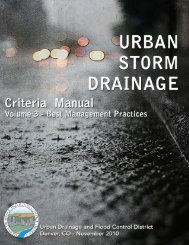Hydraulic Efficiency of Grate and Curb Inlets - Urban Drainage and ...
Hydraulic Efficiency of Grate and Curb Inlets - Urban Drainage and ...
Hydraulic Efficiency of Grate and Curb Inlets - Urban Drainage and ...
Create successful ePaper yourself
Turn your PDF publications into a flip-book with our unique Google optimized e-Paper software.
where:<br />
q 1 = dependent parameter;<br />
q 2 …q n = n-1 independent parameters;<br />
f = function relating dimensional analysis parameters q; <strong>and</strong><br />
g = unspecified function different from f.<br />
The Buckingham Pi theorem states that, given a relation among n parameters in the form<br />
<strong>of</strong> Equation 2-17, the n parameters may be grouped into n-m independent dimensionless ratios<br />
also called Pi (Π) groups (Fox, 2006). In functional form this is expressed as Equation 2-18:<br />
Π = G Π , Π , ..., Π ) or G Π , Π , ..., Π ) 0 Equation 2-18<br />
1 1( 2 3 n−m<br />
(<br />
1 2 n−m<br />
=<br />
where:<br />
Π = Pi parameter; <strong>and</strong><br />
G = function relating the dimensionless Pi parameters, related to the function f.<br />
The number m is <strong>of</strong>ten, but not always, equal to the number <strong>of</strong> dimensions required to<br />
specify the dimensions <strong>of</strong> all the parameters (q i ) <strong>of</strong> the problem or phenomena in question. The<br />
n-m dimensionless Pi parameters obtained from this procedure are independent <strong>of</strong> one another.<br />
The Buckingham Pi theorem does not predict the functional form <strong>of</strong> G, which must be<br />
determined experimentally.<br />
2.6 Significant Parameter Groups for Calculating Inlet <strong>Efficiency</strong><br />
A review <strong>of</strong> available literature has shown that the complex nature <strong>of</strong> street inlet flow has<br />
precluded the development <strong>of</strong> purely theoretical equations. Often the approach <strong>of</strong> developing<br />
empirical equations has been used. Physical variables related to gutter flow <strong>and</strong> inlet<br />
characteristics are typically identified <strong>and</strong> combined into meaningful parameter groups using<br />
dimensional analysis. Tests are performed on parameter groups to quantify their relevance.<br />
Although the method <strong>of</strong> dimensional analysis is universally applicable to development <strong>of</strong><br />
parameter groups, there are many forms that these dimensionless groups may take depending<br />
upon what parameters are used. Two <strong>of</strong> the larger studies conducted on the topic <strong>of</strong> inlet<br />
efficiency were the FHWA study on bicycle-safe grate inlets described previously (FHWA,<br />
1977) <strong>and</strong> a study completed at The Johns Hopkins University (Li, 1956). Equations developed<br />
from the FHWA study were incorporated into HEC 22 <strong>and</strong> were presented previously. The<br />
Johns Hopkins University study took a slightly different approach <strong>of</strong> regression analysis. For an<br />
17
















